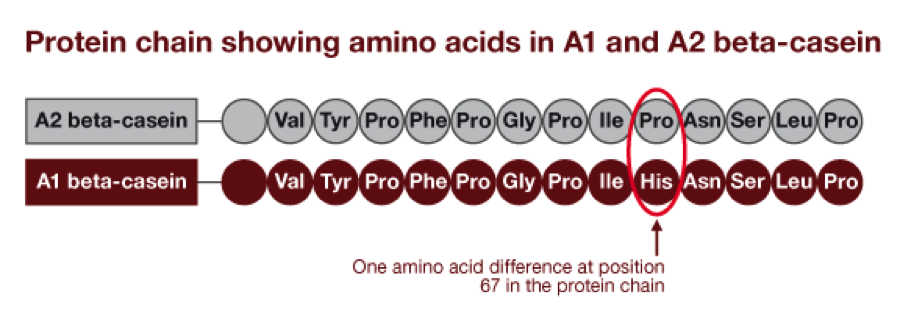It was introduced several years ago and is now being marketed in California. To further promote the consumption of milk worldwide, A2 milk will be labeled and sold in California beginning this month. This premium milk comes from cows that produce this special type of milk, as identified by the A2 Milk Company. The protein portion of milk is mostly casein and the remaining part is whey. Along with other proteins, most cows produce milk that contains two types of beta-casein, protein-A1 and A2. Studies suggest that the reported difficulty in digesting milk for some might be caused by intolerance to an A1 protein, which is found in most of the milk currently sold in America. Many of these people find A2 milk easier to digest than ordinary milk.

The cause for concern with milk containing A1 beta-casein is that through the biochemical metabolic process in humans, the 7-amino acid segment in the A1 beta-casein is separated into a molecule called beta-casomorphin-7, often abbreviated as BCM-7. BCM-7 is the real “devil” in A1 milk for a number of reasons. It is an exogenous opioid that interacts with the human digestive system, internal organs, and brainstem. Exogenous opioids do not naturally occur in the human body. While no direct causal relationships have been demonstrated between BCM-7 and these diseases due to a wide range of contributing factors for each illness, BCM-7 has been linked to type-1 diabetes, heart disease, autism, and other serious non-communicable diseases as well.

Each cow carries two copies of the gene encoding beta-casein, with a genotype of A1/A1, A1/A2, or A2/A2. Neither the A1 nor A2 trait appears to be dominant, which means that the milk produced by an A1/A2 cow will likely contain equal proportions of A1 and A2 beta-casein. A1/A1 cows will obviously only produce A1 beta-casein, just as A2/A2 cows will only produce A2 beta-casein. While each dairy herd is capable of being quite different from average, a broad characterization of the A1 or A2 genetics of breeds can be made. Northern European black-and-white breeds such as Friesian Holstein usually carry A1 and A2 alleles in equal proportion. Jersey cows and other Southern European breeds probably have about 1/3 A1 and 2/3 A2 genetics. Guernsey cows generally have about 10% A1 and 90% A2 genetics.
It is possible to breed for A2/A2 genetics. It takes roughly two and a half years for a newborn calf to grow up, have a calf of its own, and begin producing milk, so this kind of progress occurs over a multiple-year timeframe. Assuming our average cow is already 50% A2, if we can help our producers to achieve two successive generations of selectively breeding with only A2/A2 bulls it is likely that a herd could reach 100% A2 genetics in as little as five years. For purebred Holsteins it would probably take about ten years. However, the final step to get from mostly A2 to completely A2 will require testing the entire herd and selling off all carriers of the A1 beta-casein allele.
This provides a great new product to increase the consumption of milk, catering to consumers that may not normally drink milk. This milk is supplied from cows that have been handpicked because they naturally produce milk that contains only A2 protein-and no A1. A2 Milk has already taken off in the mature dairy milk market of Australia, and increased overall consumption of milk there. The launch of A2 milk in California will not only provide consumers with a nutritious, natural cow’s milk with a real digestive advantage, but also offers American dairy farmers a chance to bring people back to dairy. It is critical that the American dairy producer instill confidence in this nutritious product we produce, MILK!
Have a wonderful day! Arizona DHIA